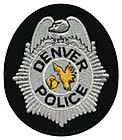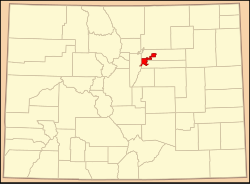Denver Police Department
| Denver Police Department | |
|---|---|
| Abbreviation | DPD |

Breast patch, No shoulder patches are worn.
|
|

Badge of the Denver Police Department
|
|
| Agency overview | |
| Legal personality | Governmental: Government agency |
| Jurisdictional structure | |
| Operations jurisdiction* | City and County of Denver in the state of Colorado, United States |
 |
|
| Map of Denver Police Department's jurisdiction. | |
| Size | 154.9 square miles (401 km2) |
| Population | 600,158 (2010) within the city & county of Denver. 2,552,195 in the metro area. |
| General nature | |
| Operational structure | |
| Sworn members | 1,459 |
| Unsworn members | 319 |
| Agency executive | Robert C. White, Chief of Police |
| Facilities | |
| Districts | 6 |
| Patrol cars | Ford Crown Victoria, Ford Expedition, Chevrolet Impala, GMC Yukon/Chevrolet Tahoe, Dodge Durango, Awaiting Ford Utility Interceptor and Pursuit Interceptor to replace aging Crown Victoria |
| Air units | 1 - 1998 Bell 407 |
| K-9 Units | Belgian Malinois and Dutch Shepherd |
| Website | |
| https://denvergov.org/content/denvergov/en/police-department.html | |
| Footnotes | |
| * Divisional agency: Division of the country, over which the agency has usual operational jurisdiction. | |
The Denver Police Department (DPD) is the full service police department jointly for the City and County of Denver, Colorado, which provides the full spectrum of police services to the entire county, including Denver International Airport, and may provide contractual security police services to special districts within the county. The police department is within the Denver Department of Public Safety, which also includes the Denver Sheriff Department and Denver Fire Department.
The current police chief is Robert C. White, who was appointed chief of police on December 12, 2011.
The Patrol Division is made up of 6 patrol districts. Within each patrol district, there are up to 3 different sectors. Each sector is made up of numerous precincts. Each precinct has one patrol car with 1-2 officers assigned it. Officers assigned to patrol work 4-10 hour shifts.
Recruits begin the DPD Academy as a recruit officer. Upon graduation, officers are classified as "police officer 4th class." After the completion of 3 years of service, officers are classified as "police officer 1st class."
http://www.thedenverchannel.com/news/29625574/detail.html AIR1 over Denver.
Breakdown of the makeup of the rank and file of DPD as of the 2007 annual report:
Denver Police have met with controversy and protest over several high-profile incidents that have led them to include citizens in their Disciplinary Review Board and Use of Force Review Board. During this period, 86 people were shot by Denver police officers, resulting in 40 deaths. In most of the 86 shootings, “the individual was clearly pointing a gun at officers.” A 2015 review of past court cases observed that Denver juries almost always acquit police officers charged with excessive force. “They realize police have to make split-second decisions to protect their own safety, and can make an honest mistake. If an officer’s version is even remotely plausible, he’ll probably get the benefit of the doubt.”
In 1953 the Denver Police Department began to gather information on individuals and groups regarding activities that might pose a threat to public safety. The files came to be known as the Spy Files during the publicity surrounding an American Civil Liberties Union class action lawsuit in 2002. According to the lawsuit, as many as 3,200 individuals and 208 organizations had been targeted for intelligence gathering operations. These groups and individuals included not only criminal elements but also peace activists and education and human rights organizations. The lawsuit was settled in 2003 with the city revising its policies governing the gathering of this type of information. Mayor John Hickenlooper ordered the records be archived at the Denver Public Library and preserved for study. Part of the archive is currently available to the public and part is a restricted collection, accessible only by those individuals and organizations specifically named in the documents. The complete collection will open to the public in the year 2055.
...
Wikipedia
